若对caltech数据集进行测评的话,需要使用code3.2.1中的dbeva.m 代码进行测评,之前不知道,很长时间里,都是自己画log average miss rate曲线,导致得到的分数就很高,结果很差,还不能解释...知道在github上看到了这位大牛的解释:
https://github.com/zhaoweicai/mscnn/issues/63
I finally managed to work this out... the devkit is so user-unfriendly
steps (the working dir of all the following steps is the folder of the devkit):
- I used the python script to generate detection results in #4 . The provided run_mscnn_detection.m was unreasonably slow for me
- create a folder "data-USA", and put the "annotations" folder of caltech in it (copy/soft-link/whatever)
- create a folder "data-USA/res, and place the unzipped results from other algorithms here (http://www.vision.caltech.edu/Image_Datasets/CaltechPedestrians/datasets/USA/res/)
- put your own results under res following the format of the official results from other algorithms
- run dbEval, and a folder named "results" will be created to store the generated graphs
FYI: the devkit evaluates 1 based 30,60,90... frames, so in python they are 29, 59, 89... and it is already well handled
行人检测FPPI miss rate
FPPI/FPPW
Miss Rate:丢失率=测试集正例判别为负例的数目/测试集检索到想要的正例数加上未检测到不想要的 即是 全部groud truth的数量
Pedestrian detection: A benchmark
两者都侧重考察FP(False Positive)出现的频率。
这周的大量时间都用在了去研究log Average Miss Rate - FPPI曲线了,昨天出来了结果。现在总结一下自己查到过的有用的知识点,使以后再用的时候不至于很费劲。
(一)绘制log Average Miss Rate - FPPI曲线所使用的函数及其参数
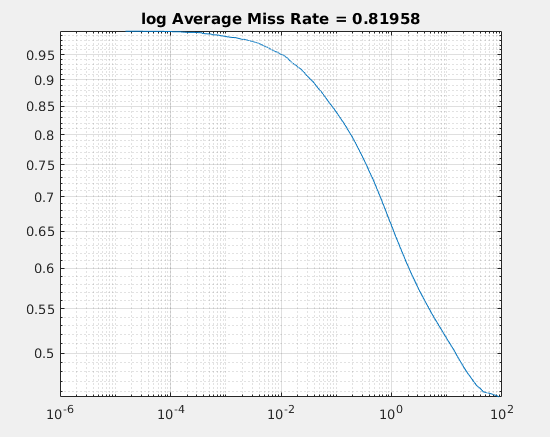
图(0) log Average Miss Rate - FPPI曲线
关于log Average Miss Rate - FPPI 曲线,是用来衡量行人检测的检测器效果的衡量指标,曲线越低,效果越好。
画log Average Miss Rate - FPPI曲线,matlab2017版本提供了专门的函数,函数的详细用法,在matlab的官方文档中已经给出。
%detectionResults 是你检测器生成的关于每幅图像的 boundinb boxes 和对应与每个bbox 得到的分数 见图(1) %trainingData 是你数据关于每幅图像标定的 ground truth 见图(2) [am,fppi,missRate] = evaluateDetectionMissRate(detectionResults,trainingData)
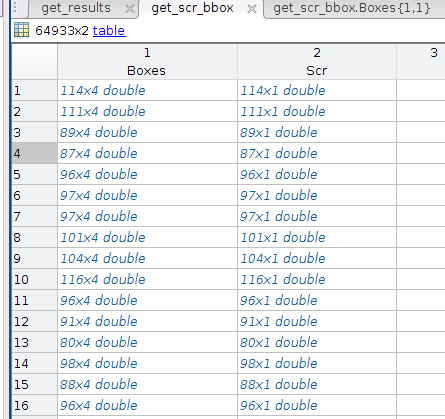
图(1-1) detectionResults的具体结果展示
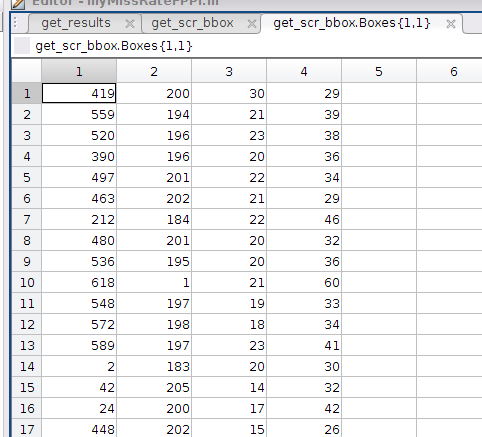
图(1-2) Boxes 中可以是一个double 类型的矩阵

图(1-3) Scr中是与Boxes一一对应的分数,Scr也是double类型的
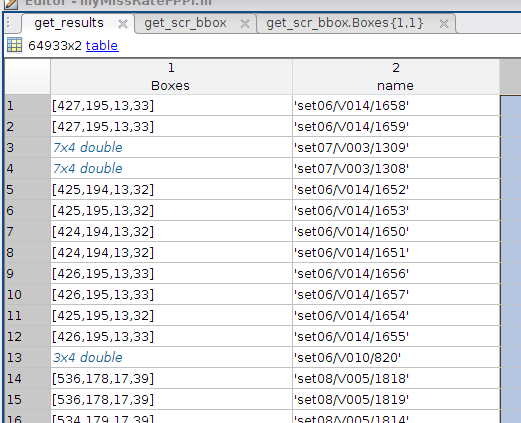
图(2) trainingData的具体结果展示(这里的3*4 double 类型同上边的图中一样)
有了这些数据后,传给函数 evaluateDetectionMissRate() 就能得到最终的结果,然后用miss rate 和FPPI绘制最终的曲线
figure
loglog(fppi, missRate);
grid on
title(sprintf('log Average Miss Rate = %.5f',am))
我的整体代码是

[am,fppi,missRate] = evaluateDetectionMissRate(get_scr_bbox,get_results(:,1),0.5); %% % Plot log average miss rate - FPPI. figure loglog(fppi, missRate); grid on title(sprintf('log Average Miss Rate = %.5f',am))
(二)将的到的检测结果文件和ground truth整理成matlab容易读取的格式
从检测器得到的结果中,取得具体对应每张图片的分数和它的bboxes。因为检测得到的结果比较大,有200M+,所以,对于这么大的文本,处理方法还是很关键的
因为每张图片 与(分数score和bbox)是一对多的关系,也就是说,一张图片会有多个(分数score和bbox),所以存储的时候就要考虑好。
这里我用的python 中的字典(dict)对图片和(分数score和bbox)进行存储,key是图片名,value是一个存放多个(分数score和bbox)的 list。这样在具体查找当前的图片名是否已经保存在字典中,因为字典的性质,就可以相当快了。
(i)检测器的到的数据的格式
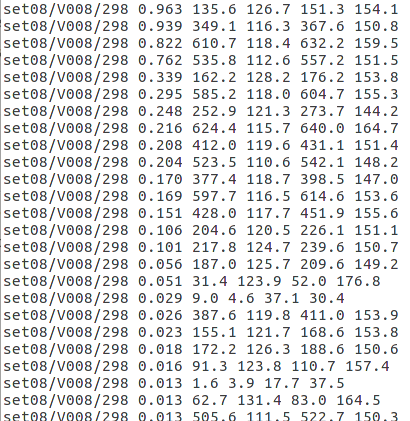
图(3) 检测器的到结果的具体展示
(ii)用matlab 处理前,要整理成的格式
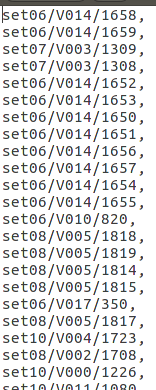
图(4-1)生成的out.txt文件,用来保存图片的名字,之后用ground truth 来与这个文件里的名字对应起来
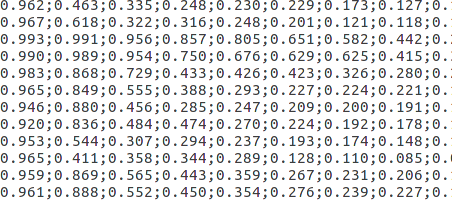
图(4-2)生成的out1.txt文件,用来保存每张图片对应的bboxes 的具体分数,会有很多维
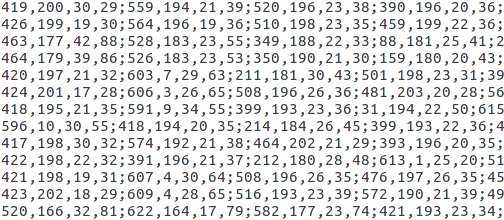
图(4-3)生成的out2.txt文件,用来保存每张图片对应的bboxes,这里的坐标的含义是:前两个是bbox 的的左上坐标点,然后后两个是它的宽和高。
(iii)具体代码:

def generate_result(resource_path, des_path): """ :param path: :return: """ des_path1 = "/home/user/PycharmProjects/MissRate_FPPI_plot/out1.txt" des_path2 = "/home/user/PycharmProjects/MissRate_FPPI_plot/out2.txt" rf = open(resource_path) content = rf.readline() cnt = 0 tmp_dict = {} while content: #print content res = content.replace(" ", "").split(" ") cls = str(res[0:1][0]) bbox = res[1:6] if cls in tmp_dict: tmp_dict[cls].append(bbox) else: tmp_dict[cls] = [bbox] cnt += 1 content = rf.readline() rf.close() wpath = resource_path.split("/")[-1] respath = wpath[-9:-4] + "/" + wpath[-4:] print wpath, respath wfname = open(des_path, "a+") wfscr = open(des_path1, "a+") wfbbox = open(des_path2, "a+") for key_ in tmp_dict: wfname.write(str(key_)+',') for detail in tmp_dict[key_]: for index in detail: if index == detail[0]: wfscr.write(str(index)) else: if index is detail[1]: tmpp1 = index wfbbox.write(str(int(float(index)))) if index is detail[2]: tmpp2 = index wfbbox.write(str(int(float(index)))) if index is detail[3]: wfbbox.write(str(int(float(index) - float(tmpp1)))) if index is detail[4]: wfbbox.write(str(int(float(index) - float(tmpp2)))) if index is not detail[-1]: wfbbox.write(",") if len(tmp_dict[key_]) > 1: if detail is not tmp_dict[key_][-1]: wfscr.write(";") wfbbox.write(";") wfname.write(" ") wfscr.write(" ") wfbbox.write(" ") wfname.close() wfscr.close() wfbbox.close() generate_result("/home/user/PycharmProjects/MissRate_FPPI_plot/comp4_det_test_person.txt", "/home/user/PycharmProjects/MissRate_FPPI_plot/out.txt") def generate_all_result(path): import os dirList = [] fileList = [] files = os.listdir(path) for f in files: if(os.path.isdir(path + "/" + f)): if f[0] != '.': dirList.append(f) if(os.path.isfile(path + '/'+ f)): fileList.append(f) for fl in fileList: generate_result(path + fl, "/home/user/PycharmProjects/MissRate_FPPI_plot/out.txt") #generate_all_result("/home/user/Downloads/caltech_data_set/test/")
还需要得到ground truth的具体信息
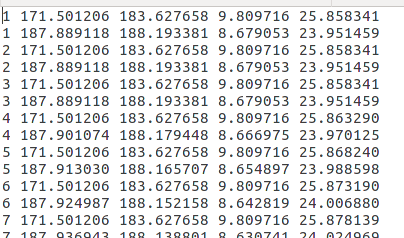
图(5) ground truth 标注
一张图片也可能有多个标注信息,同要也需要处理 ,想法同上边是一样的,将图片名当做key,然后用list 作为value,保存ground truth bboxes

def generate_result(resource_path, des_path): """ :param path: :return: """ supname = resource_path[-9:-4] + "/" + resource_path[-4:] + "/" print supname rf = open(resource_path) content = rf.readline() cnt = 0 tmp_dict = {} while content: #print content res = content.replace(" ", "").split(" ") cls = supname + str(res[0:1][0]) bbox = res[1:5] if cls in tmp_dict: tmp_dict[cls].append(bbox) else: tmp_dict[cls] = [bbox] cnt += 1 content = rf.readline() rf.close() wpath = resource_path.split("/")[-1] respath = wpath[-9:-4] + "/" + wpath[-4:] print wpath, respath wfname = open(des_path, "a+") for key_ in tmp_dict: wfname.write(str(key_)+',') for detail in tmp_dict[key_]: for index in detail: if index is detail[0]: tmpp1 = index wfname.write(str(int(float(index)))) if index is detail[1]: tmpp2 = index wfname.write(str(int(float(index)))) if index is detail[2]: wfname.write(str(int(float(index)))) if index is detail[3]: wfname.write(str(int(float(index)))) if index is not detail[-1]: wfname.write(" ") if len(tmp_dict[key_]) > 1: if detail is not tmp_dict[key_][-1]: wfname.write(",") wfname.write(" ") wfname.close() def generate_all_result(path): import os dirList = [] fileList = [] files = os.listdir(path) for f in files: if(os.path.isdir(path + "/" + f)): if f[0] != '.': dirList.append(f) if(os.path.isfile(path + '/'+ f)): fileList.append(f) for fl in fileList: generate_result(path + fl, "/home/user/PycharmProjects/MissRate_FPPI_plot/new_ground_truth.txt") generate_all_result("/home/user/Downloads/caltech_data_set/data_reasonable_test/")
最后的效果是:

图(6)生成的finally_ground_truth.txt文件,最后的ground truth 结果
最后,用finally_ground_truth.txt文件和out.txt文件生成 ground truth bbox 同检测图片一一对应的结果。

图(7) 生成的与out.txt 对应的ground truth bboxes 结果(为result_pair1.txt文件)(可以同图(4-1)对比,这两个文件的名字顺序是相同的)
有了每张图片对应的bboxes的分数(out1.txt)、每张图片对应的bboxes(out2.txt)、和每张图片的对应的ground truth bboxes (result_pair1.txt)这些文件,
然后接下来用matlab读取这些文件,然后生成 [am,fppi,missRate] = evaluateDetectionMissRate(detectionResults,trainingData)中对应的detectionResults 和 trainingData
(i)生成的detectionResults保存在get_scr_bbox中

fid=fopen("/home/user/PycharmProjects/MissRate_FPPI_plot/result_pair1.txt", "rt"); data = textscan(fid, '%s', 'delimiter', ' '); data = data{1,1}; %debug % A = data{3} % % % A = regexp(A, '-', 'split') % B = A(2) % % B = transpose(str2num(cell2mat(B))) % % B = str2num(cell2mat(B)) % S = regexp(B, ';', 'split') % res = [] % [m,n] = size(S) % for i = 1:n % res = [res;S(i)] % end get_results(64933) = struct('Boxes',[],'name',[]); for i=1:64933 A = data{i} A = regexp(A, '-', 'split') get_results(i).name = A(1) B = A(2) B = str2num(cell2mat(B)) get_results(i).Boxes = B end % get_results = struct2table(get_results); while feof(fid) ~= 1 file = fgetl(fpn); end fclose(fid);
(ii)生成的trainingData保存在get_results中

fid1=fopen("/home/user/PycharmProjects/MissRate_FPPI_plot/out2.txt", "rt"); fid2=fopen("/home/user/PycharmProjects/MissRate_FPPI_plot/out1.txt", "rt"); data1 = textscan(fid1, '%s', 'delimiter', ' '); data2 = textscan(fid2, '%s', 'delimiter', ' '); data1 = data1{1,1}; data2 = data2{1,1}; %debug %A = data1{1} %A = cellstr(A) % %A = regexp(A, ';', 'split') %A = str2num(cell2mat(A)) %B = data2{1} %B = cellstr(B) %B = str2num(cell2mat(B)) % B = A(2) % % B = transpose(str2num(cell2mat(B))) % % B = str2num(cell2mat(B)) % S = regexp(B, ';', 'split') % res = [] % [m,n] = size(S) % for i = 1:n % res = [res;S(i)] % end % get_scr_bbox(64933) = struct('Boxes',[],'Scr',[]); for i=1:64933 A = data1{i} A = cellstr(A) A = str2num(cell2mat(A)) B = data2{i} B = cellstr(B) B = str2num(cell2mat(B)) get_scr_bbox(i).Boxes = A get_scr_bbox(i).Scr = B end % get_scr_bbox = struct2table(get_scr_bbox); % while feof(fid) ~= 1 % file = fgetl(fpn); % end fclose(fid1); fclose(fid2);
(iii) 最后,使用 [am,fppi,missRate] = evaluateDetectionMissRate(detectionResults,trainingData) 就可以得到最终的结果(代码在最开始)
(三)相关知识点整理
(1)Python debug —— invalid literal for int() with base 10
int(float("1.5"))
(2)matlab中的cell array, cellstr()和char()的用法
(3)MATLAB元胞数组
(4)用Matlab实现字符串分割(split)
(5)Matlab---------字符串分割(split)
S = regexp(str, 's+', 'split')
(6)matlab怎样将输入的数字字符矩阵转化为数值矩阵?
(7)matlab中cell数组的全面介绍
cell2mat
(9)matlab将cell型变成double型
>> A=transpose(str2num(cell2mat(test')))
1 1 1 1 2 2 2 2 3 3 3 3 4 4 4 4
(10)matlab如何取矩阵的某一行,或某一列
x=A(i,j);就是提取矩阵A的第i行,第j列的元素注:提取元素是MATLAB中最常用的操作x(1,:)代表提取第1行,从第1列到最后一列;x(:,1)代表提取第1列,从第1行到最后一行;其他的还有提取最大值最小值等操作,可以多看下help.或者提取矩阵A的第一行,第二列,赋给aa=A(1,2);如果光要取第一行a=A(1,:);如果光要取第二列a=A(:,2);
(11)Matlab 文件操作 [转]
(12)Matlab文件操作及读txt文件
(13)matlab 中的textscan
fid = fopen('mydata1.txt'); C = textscan(fid, ''%s%s%f32%d8%u%f%f%s%f'); fclose(fid);
(14)Python 实现图片加框和加字
from matplotlib import pyplot as plt import cv2 im = cv2.imread("/home/user/PycharmProjects/MissRate_FPPI_plot/image001.jpg") cv2.rectangle(im,(int(856),int(318)),(int(856+39),int(318+41)),(0,225,0),2) plt.imshow(im) plt.show()
(15)【搬砖】【PYTHON数据分析】PYCHARM中PLOT绘图不能显示出来
(16) python 中dict 的value 是list
tmp_dict = {} while content: #print content res = content.replace(" ", "").split(" ") cls = str(res[0:1][0]) bbox = res[1:6] if cls in tmp_dict: tmp_dict[cls].append(bbox) else: tmp_dict[cls] = [bbox] cnt += 1 content = rf.readline()
若对caltech数据集进行测评的话,需要使用code3.2.1中的dbeval 代码进行测评,之前不知道,很长时间里,都是自己画log average miss rate曲线,导致得到的分数就很高,结果很差,还不能解释...知道在github上看到了这位大牛的解释:
https://github.com/zhaoweicai/mscnn/issues/63
I finally managed to work this out... the devkit is so user-unfriendly
steps (the working dir of all the following steps is the folder of the devkit):
- I used the python script to generate detection results in #4 . The provided run_mscnn_detection.m was unreasonably slow for me
- create a folder "data-USA", and put the "annotations" folder of caltech in it (copy/soft-link/whatever)
- create a folder "data-USA/res, and place the unzipped results from other algorithms here (http://www.vision.caltech.edu/Image_Datasets/CaltechPedestrians/datasets/USA/res/)
- put your own results under res following the format of the official results from other algorithms
- run dbEval, and a folder named "results" will be created to store the generated graphs
FYI: the devkit evaluates 1 based 30,60,90... frames, so in python they are 29, 59, 89... and it is already well handled
感觉有点走上正规的感觉,哈哈哈哈
